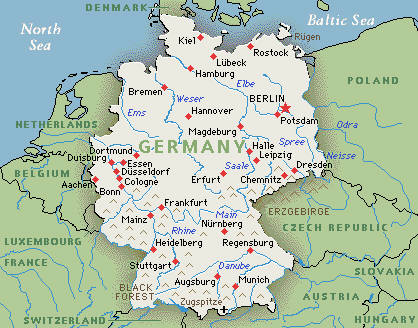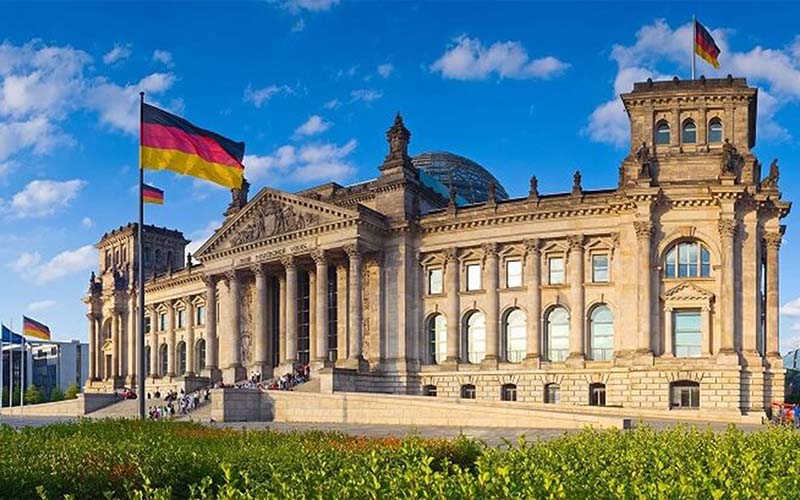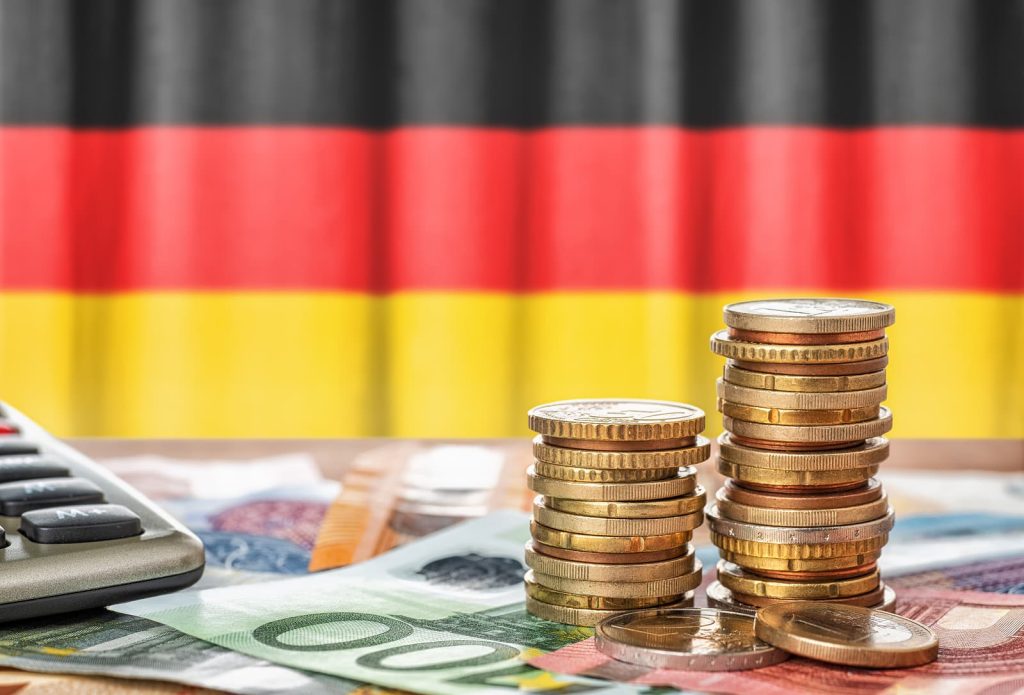Germany, a vast country in the heart of Europe, with its rich history, dynamic culture and impressive technologies, has always been an attractive destination for tourists, immigrants and investors. The green plains and the majestic Alps to the beautiful and rich ancient monuments are only a part of the impressive and strong attractions in Germany. With a long history in music, philosophy, literature and basic sciences, this country has played a key role in the history and culture of Europe. An industrial country that is a member of the Schengen Agreement, and by receiving its visa, you will have the chance to travel easily and hassle-free to 26 other European countries members of the Schengen Agreement.
In this article, we will have a trip to Germany and we will examine the introduction of this country and we will provide you with complete information from the general introduction of Germany and its important cities to the climate, geography, economy, benefits of life, tourist attractions and accommodation.
Germany, a world of progress and technology
The Federal Republic of Germany, with an area of about 357,000 square kilometers, is the second largest country in the European Union after France. The population of this country is around 83 million people, which is also the most populous country in the European Union. But the capital of Germany is the city of Berlin, which is known as one of the most dynamic and attractive cities in the world with unique historical and cultural attractions. The country is made up of 16 states that share many cultural similarities, including language, beliefs, etc. Important states include Bavaria, Baden-Württemberg, Hesse, North Rhine-Westphalia and Mecklenburg-Western Pomerania. The official language of Germany is German and it is interesting to know that other countries such as Austria and Switzerland also speak the same language. This issue can show the power and influence of Germany in other European countries.
This country is known as one of the most dreamy countries in the world. If you are planning to travel or immigrate to Germany, you can benefit from the expertise and experience of Nobility Institute consultants.
German geography
Germany is a vast country in the heart of Europe with diverse and rich geography. This country is bordered by the North Sea and the Baltic Sea from the north, Poland and the Czech Republic from the east, Austria and Switzerland from the south, and France, Luxembourg, Belgium and the Netherlands from the west. With an area of 357,114 square kilometers (137,846 sq mi), Germany is the 35th largest country in the world by area. The population of Germany is about 83 million people, which makes this country the most populous country in the European Union.
The country is divided into three main regions, which include the Northern Plain (a flat and fertile region along the coasts of the North Sea and the Baltic Sea), the Middle Mountains (a region that includes various mountain ranges such as the Hartz, the Black Forest, and the Bavarian Alps), and the Southern Plain (the plains of It is vast and fertile like Bavarian plain and Baden plain).
In addition to all the things that have been said, Germany has many rivers and lakes that have given a special charm to the nature of this country. It is worth mentioning that Germany has various natural resources such as coal, lichenite, potash, uranium and forests.

History of Germany
German history is full of epic ups and downs, powerful battles and deep cultural transformations. Located in the heart of Europe, this land has long witnessed the rise and fall of empires, intellectual movements and social transformations.
Early period: In ancient times, Germanic tribes lived in the lands of today’s Germany. The Romans conquered parts of this land in the first century AD and established the Germanic Roman Empire. With the fall of the Roman Empire in the 5th century, Germanic tribes once again dominated the land and formed numerous kingdoms.
Roman Empire: In 962 AD, Otto I, King of Saxons, took the throne of the Holy Roman Empire. This empire, which consisted of the lands of Germany, Italy and Burgundy, lasted until the 19th century. The era of the Holy Roman Empire saw the flourishing of culture and art in Germany, but was accompanied by constant tensions between the emperor and local princes, as well as religious wars.
Reformation and Thirty Years’ War: In the 16th century, the Reformation movement led by Martin Luther divided Germany into two Catholic and Protestant fronts. The Thirty Years’ War (1648-1618) followed by a religious schism that brought widespread destruction and death and severely weakened the emperor’s power.
Rise of Prussia and German Unification: In the 18th century, the Kingdom of Prussia emerged as a military power in Germany. In 1871, after victory in the Franco-Prussian Wars, Prussian Chancellor Otto von Bismarck united the German Empire with the Kingdom of Wilhelm I. This new empire quickly became a powerful industrial and military power in Europe.
World war
World War I and II: The German Empire suffered defeat in World War I (1918-1914) and was forced to accept the Treaty of Versailles. This treaty severely weakened Germany and imposed heavy reparations on it. In 1933, Adolf Hitler and the Nazi Party took power in Germany. Hitler prepared Germany for war and started World War II by invading Poland in 1939. Germany suffered a catastrophic defeat in this war and after that it was divided into two countries, West Germany and East Germany.
German Partition and Reunification: The Cold War (1991-1947) divided Germany into two blocs, East and West. With the support of the United States and its allies, West Germany became a democratic and prosperous country, while East Germany came under communist rule. In 1989, with the fall of the Berlin Wall, East and West Germany were reunited. A united Germany emerged as a powerful economic and political power in Europe and the world.
Today’s Germany: Today, Germany is a democratic, federal and parliamentary country with a strong economy and a high standard of living. This country is a member of the European Union, the Schengen Agreement, the United Nations and NATO. Germany is recognized as a leader in the fields of science, technology, culture and art.
This was just a summary of Germany’s complicated and tumultuous history. You can refer to this article for a more complete history of Germany.
The most important cities in Germany
Berlin
Berlin is the largest and most populous city in Germany with more than 3.6 million inhabitants. This city is located in the north-east of the country, along the Schepper and Hofel rivers, and is the center of the Berlin/Brandenburg metropolitan area, which has a population of nearly six million. Berlin has a long and turbulent history. This city was severely destroyed in World War II and after the war it was divided into two parts, East and West. A symbol of the Cold War, the Berlin Wall separated the city for 28 years until it came down in 1989. Berlin is a multicultural city where people from all over the world live. This cultural diversity is evident in the food, music, art and architecture of the city.
Berlin is also known as one of the most important artistic and cultural centers of Europe and hosts some of the most famous museums, galleries, theaters and orchestras. The Brandenburg Gate, the Berlin Wall, the Island Museum, the Reichstag Tower and the Holocaust Memorial are among the main attractions of Berlin.
Munich
Germany’s second largest city, with more than 1.5 million people, is located in the south of the country in the state of Bavaria, which has a total of 6 million people. Munich was founded in the 12th century by the dukes of Bavaria and quickly became an important commercial and cultural center. This city was the capital of Bavaria for many centuries and in 1813 witnessed the signing of the treaty that ended the Napoleonic Wars. Munich was heavily bombed in World War II, but was rebuilt after the war and became one of the most modern and wealthy cities in Germany. It is interesting to know that Munich has one of the strongest economies in Germany and is an important center for industries such as engineering, information technology, automotive, media and tourism. The city is also home to several major global companies such as BMW, Siemens, Allianz and MAN.
Marianplatz, Pinakothek Museum, New Schwanstein Palace and Allianz Arena are among the most important attractions of this city.
Hamburg
Hamburg, another of Germany’s largest cities with a population of over 1.8 million, is located in the north of the country along the Elbe River. It is an important port city and the center of trade and industry in Germany and is known as the “Blue Gate of Europe”. Hamburg has been attacked and looted many times throughout history, but has always rebuilt itself. In World War II, Hamburg was heavily bombed like Munich, but after the war it was quickly rebuilt to be known as one of the most important cities in the country today. Hamburg is a multicultural city where people from all over the world live. This cultural diversity is evident in the food, music, art and architecture of the city. Hamburg is also famous for its lively nightlife.
Hamburg has one of the strongest economies in Europe and is an important center for industries such as transport, media and tourism. The city is also home to several major global companies such as Airbus, Hapag-Lloyd and Otto.
If you plan to visit Hamburg’s sights, we recommend visiting St. Michael’s Church, Hamburg Museum, and Hamburg Cathedral.
Frankfurt
Frankfurt, with about 760,000 inhabitants, is another densely populated city and one of the most important financial and commercial centers in Europe. This city is located in the state of Hesse in the west of this country and next to the Mein River. Frankfurt is known as the financial center of Europe and is home to some of the largest banks, financial institutions and international companies. The city is also an important center for trade, transportation and trade fairs. In this city, like other cities, there is a high cultural diversity. This cultural diversity is evident in the food, music, art and architecture of the city. It is worth noting that Frankfurt is known for its many museums, theaters and operas. The Römer Museum, the Städel Museum, the Hamburg Cathedral and the Essenheim area are among the most beautiful tourist attractions in Frankfurt.
Köln
Cologne, the fifth largest city in Germany with more than 1.1 million inhabitants, is located in the west of the country on the banks of the Rhine River. The city is known as the center of the Cologne-Bonn metropolitan area, which has a population of about 10 million. In the Middle Ages, this city was known as one of the most important religious and cultural centers in Europe. Cologne is home to Cologne Cathedral, which is one of the most famous churches in the world. Cologne is famous for its annual carnival, which is the largest in Europe. This carnival is held every year on the 11th day of the 11th month of the year at 11:11. The Chocolate Museum, the Schildglasse district, the Cologne Cathedral and the Hohenzollern Bridge are among the most prominent sights in the city of Cologne.
Weather conditions in Germany
Germany is a vast country with a diverse climate. This diversity is due to its geographical location, in the heart of Europe and influenced by various factors including ocean currents, altitude and proximity to the sea. Overall, the country has a temperate continental climate, meaning it has four distinct seasons with hot summers and cold winters. However, the climate varies considerably across the country. Join us to check the weather conditions in different parts of Germany.
In northern Germany, the climate is influenced by the North Sea and the Baltic Sea, and is generally cooler and wetter than the rest of the country. In this region, winters are mild and summers are cool, and rainfall is relatively uniform throughout the year. Northern cities such as Hamburg, Berlin and Bremen are examples of this climate.
But the climate of the south is influenced by the Alps and warm Mediterranean winds. The climate of this region is generally hotter and drier than the north, so that winters are colder and snowy, and summers are hot and sunny, and more precipitation occurs in late spring and early summer in the form of showers and spring rains. Munich, Stuttgart and Freiburg are examples of southern cities with this climate.
It is interesting to know that the climate of central Germany is a combination of northern and southern climates. In this region, in general, winters are cold and summers are hot, and precipitation is relatively evenly distributed throughout the year. Frankfurt, Cologne and Dusseldorf are among the central cities with this climate.
West and East of Germany
The weather in the east of this country is influenced by continental air masses from the east. In general, winters are colder and longer and summers are warmer and shorter than in West Germany. It is worth noting that annual precipitation averages between 500 and 600 mm (20 and 24 in). The cities of Dresden and Leipzig are among the eastern cities of Germany that have this type of climate.
But the climate of the western regions is influenced by the ocean currents from the west. In these areas, winters are milder and shorter and summers are cooler and longer than in eastern Germany, with annual precipitation averaging between 600 and 800 mm (24 and 31 in).
With the definitions provided, if you travel to Germany, in winter, you can enjoy winter sports like skiing and snowboarding in the Alps, and in spring and summer, you can enjoy hiking, biking, and exploring the beautiful natural scenery. It is worth noting that you should not miss the pleasure of watching autumn colors in the natural landscapes of this country.
Important and vital industries in Germany
Germany is known as a leading industrial country in various fields. These developments have caused the country’s demand for labor to increase sharply and specialists from all over the world enter this country to get better and more job opportunities. Famous automobile brands such as Mercedes-Benz, BMW, Audi, Volkswagen and Porsche operate in Germany. In the machine industry, Siemens, Bosch, ThyssenKrupp and Hanel companies are also among the flagships. Meanwhile, advanced chemical and pharmaceutical companies such as BASF, Bayer and Henkel, Bayer, Merck KGaA and Boehringer Ingelheim are pursuing their activities in Germany.
That is why this country is known as a good opportunity for job seekers. If you want to immigrate to Germany to get better job opportunities, you can reach your goal by using the expertise of Nobility Institute’s experienced experts.
German economy
It is enough for the professionalism of the German economy that the economy of this country is the largest economy in Europe and the fourth largest economy in the world. With high economic stability, low unemployment rate and high standard of living, this country is known as one of the strongest economies in the world and is an export-oriented country in the field of production and export of automobiles, machinery, chemicals, pharmaceutical products and electronics. France, America, China, the Netherlands and Italy are among Germany’s most important trading partners, and most of Germany’s trade is with these countries. Today, various industries account for about 28% of the GDP. Various services, including transportation, communication, etc., account for 70% and agriculture accounts for less than 2% of the GDP.
The best universities in Germany
Join us to review some of the best universities in Germany.
We invest in talent and knowledge is the profit we get. This sentence is the slogan of the Munich University of Technology, which is one of the best educational and research institutions in Germany, which dates back to 1868 and is located in the city of Munich. According to the QS ranking, this university is ranked 53 among all universities, which is an extraordinary number. The presence of 15 faculties, including the Faculty of Medicine, Aviation, Architecture, Biology, Chemistry, Economics, Mathematics, etc., has made this university one of the largest educational institutions in Germany.
But let’s introduce the oldest university in Germany. The establishment of this university dates back to 1386, and today according to QS statistics, this university is ranked 72 in the world. The fields of medicine, biological sciences, chemistry, geology, astronomy and economics, etc., are among the most popular fields of study in this educational institution. It is interesting to know that today more than 20 thousand students are studying in this university.
But let’s introduce another top educational and research center in Germany and even Europe. LMU was founded in Munich in 1472. The high quality of education in this university has made LMU rank among the top 100 universities in the world in most rankings. It is interesting to know that about 15% of the students of this university, whose number reaches 7000, are foreigners and study in this international university. Medicine, economics, law, veterinary medicine, history, art, etc., are among the most important fields of study in this high-level university.
Advantages of living in Germany
Germany, as one of the most advanced countries in the world, pays great attention to the quality of life of its residents. In the following, we will introduce you to some of the benefits of living in this country.
- Strong economy and high economic stability
- Low unemployment rate
- High standard of living
- Strong health, medical and educational infrastructures
- High social security
- cultural diversity
- Beautiful Nature
German tourist attractions
Besides being a successful country in terms of industry, economy and quality of life, Germany also has beautiful tourist attractions. In this part of the article, we are going to introduce a number of spectacular works in this country. Stay with us.
Lake Constance, Baden-Württemberg
It is natural that Germany, as a European country, has many natural landscapes. One of the most popular natural tourism areas in this country is Lake Constance. Lake Constance is one of the largest border lakes in Europe, located between Germany, Austria and Switzerland. This lake, with its beautiful natural scenery, water activities and convenient geographical location, is a popular destination for tourists and those interested in recreational and adventurous activities. If you are also interested in water sports and walking by a beautiful lake, visiting this place is a good choice for you.
Neuschwanstein, Bavaria
Do not pay attention to the hard name of this work. Neuschwanstein is one of the masterpieces of Baroque architecture in Germany, located in the Bavaria region. This castle, with its unique design and beautiful natural scenery around it, is known as one of the popular tourist destinations in this country. This palace dates back to the 19th century and is still one of the most visited places in Germany. According to official statistics, Neuschwanstein Castle holds the record for the most visited castle in Germany.
Zoological Garden, Berlin
Berlin Zoo, also known as Berlin Zoological Garden, is the most famous and most advanced zoo in Europe. This old zoo dates back to 1844. Today, in addition to the zoo, we can also see a very large and advanced aquarium in this place, which is famous all over the world. The existence of different animal species in this 34-hectare zoo has made it one of the most special tourist attractions in Germany and even Europe.
Sanssouci Palace, Potsdam
At first, you might think that the city of Potsdam is a small and insignificant city in Germany. But when you read a little more about this city, you will notice the presence of an extraordinary work in it. Sanssouci Palace is one of the masterpieces of Baroque architecture in Germany, located in the city of Potsdam. This palace is known for its beautiful design and beautiful interior and exterior artistic decorations and has been used as a venue for important meetings and events throughout history. If you ever go to Germany, try to visit this spectacular work.
Brandenburg Gate, Berlin
This place is a historical monument from the 18th century in the city of Berlin, the capital of Germany. The architectural style of this gate is the neoclassical style, and this has made it a special work in Germany. The purpose of building this building was for people to recognize it as a symbol of peace. When Berlin was divided into East and West, this gate was located on the border of these two areas. But when peace was established, this gate became more and more a symbol of peace, and even today, people remember the events of that era by watching this work.
Get German residency
According to the definitions that were made, it is natural to want to introduce Germany as one of the best destinations for immigration. Many goals such as education, work or life make people migrate to foreign countries. In this part, we are going to review the conditions for obtaining residence in this country together. Stay with us.
Educational immigration
Studying in this country can be the dream of many people. This country considers many facilities for foreign students in order to cultivate a new workforce for itself. One of the difficulties of studying in Germany is that you have to master the German language to cope with the conditions. It is worth mentioning that even if you pass the entrance exam in Iran, you can apply to study in Germany and spend 4 years to get a bachelor’s degree. Contact us for academic accommodation advice.


work migration
The existence of various industries in Germany has caused this country to face a labor shortage and to make great efforts to attract labor. This workforce is imported to Germany in the fields of healthcare, various industries, administrative affairs, etc. But the thing that makes it difficult for some people is that this job offer must first be advertised in Germany for 3 months. If the applicant is not found for this job, it must be advertised in EU countries in 3 months. Finally, if no applicant is found for this job, other people can enter this job. If you have a job in Germany for 4 years, then you can get a permanent German residence.
Immigration by investment
Investing in developed countries is one of the best ways to preserve capital and progress. In Germany, you can also apply for residency by investing in company registration. Note that the fee paid for company registration must be at least 25,000 euros. But if you intend to establish a joint stock company, the value of this company must be more than 50 thousand euros to be accepted by the German government. For this purpose, you need the advice of an experienced person. Our experts at Nobility Institute are ready to accompany you from 0 to 100.


Immigration through marriage
Marrying someone who has the citizenship of the country you want can be an easy shortcut to get the residency of that country. This also applies to Germany. But there are conditions that we will examine further. First of all, note that you must know German up to A1 level. Another condition that is necessary to be able to obtain German residency is that you must live with your spouse for at least 3 years and then apply for permanent German residency.
Golden Visa (Golden Visa) Germany
German Golden Visa is one of the best investment visas in this country. In order to receive this visa, it is necessary for people to have certain conditions to succeed in receiving it. Conditions such as having a significant financial capital (at least one million euros), work and study experience approved by the German authorities and a special program for investment in Germany. In addition, you must have a good command of the German language. After you meet these expectations, you can apply for a German Golden Visa.
One of the main activities of Nobility Immigration Institute is consulting on obtaining German investment visas and golden visas. You can contact us for advice and more information.
Germany is a country with rich history, dynamic culture, strong economy, diverse tourist attractions and high standard of living. This country is an attractive destination for tourists, immigrants and investors from all over the world. Thank you for staying with us until the end of this article. We hope that the information presented in this article was useful for you. At Nobility Institute, we specialize in the field of consulting for obtaining residency in European countries, especially Germany. If you also plan to visit Germany or immigrate to this country, you can achieve your wish by using the expertise of our consultants. contact us.
